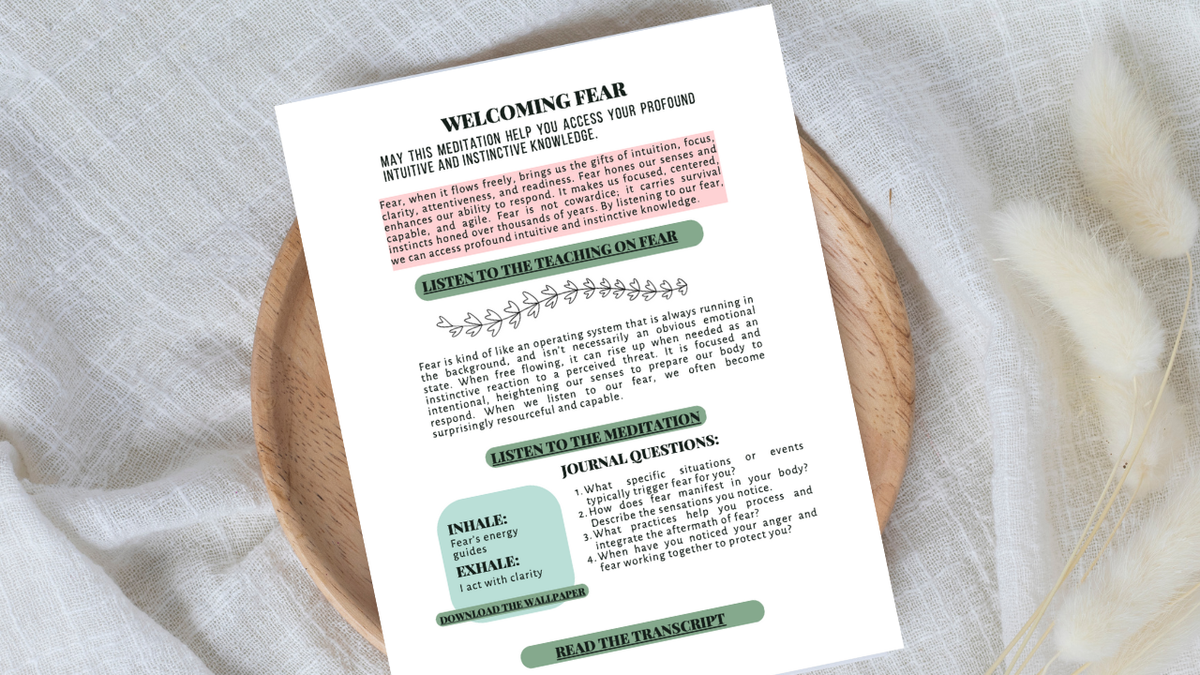Welcoming Fear Guided Meditation
May this meditation help you access your profound intuitive and instinctual knowledge.

This meditation is part of a series that focuses on what we might typically see as our “harder” or less acceptable emotions. Many of us have learned to push away these less desirable emotions based on a variety of reasons, perhaps religious, cultural, or social. Yet we know that it’s not healthy for us to repress emotions, and our meditation practice helps us create space for what is present within ourselves, even if it’s hard to face.
We want to learn to understand our emotions better, what they’re trying to tell us, and identify how they show up in our body, so that we can then work with our emotions and use the gifts they bring us instead of fighting against them. n this short teaching before our meditation, we'll explore how fear helps us to use our intuition to respond to whatever life throws at us. My teachings and the following meditations have been greatly informed by my study of Internal Family Systems Therapy or “parts work,” Somatic Experiencing, and the book “The Language of Emotions” by Karla McLaren.
If you'd rather listen, you can hear a recording of the information below on Insight Timer.
Understanding Fear
Fear, when it flows freely, brings us the following gifts:
Intuition: Heightens our awareness and connects us to our deeper instincts.
Focus: Sharpens our senses and aligns our actions with our immediate needs.
Clarity: Helps us see situations clearly and respond effectively.
Attentiveness: Keeps us present and engaged with our environment.
Readiness: Prepares us for change and equips us to handle new challenges.
When fear flows freely, it hones our senses and enhances our ability to respond. It makes us focused, centered, capable, and agile. Fear is not cowardice; it carries survival instincts honed over thousands of years. By listening to our fear, we can access profound intuitive and instinctual knowledge.
How Fear Manifests in Your Body
Fear is not just a mental or emotional state; it's a physical experience that involves our entire body. Everyone experiences fear differently, and these body responses can be influenced by individual differences, cultural factors, and personal history. In uour meditation practice, just be aware of what is happening in your body and see if you can identify it.
Fear communicates through sensations and urges. It might tell you to slow down, stop, or take action. These signals often come as queasy feelings, sudden insights, or nagging thoughts. Trust these messages and ask yourself, "What action should be taken?"
Physical manifestations of fear can include increased Heart Rate and Palpitations, shallow or rapid breathing, muscle tightness, clammy skin, stomach upset or butterflies, dry mouth, or numbness.
Creating Boundaries
Anger and fear work in tandem. Anger helps us set boundaries, while fear maintains our focus and preparedness. By setting strong personal boundaries, we create a sacred space where our fear can flow freely, bringing us readiness, focus, and calm.
The Difference Between Fear and the Aftermath of Fear
Understanding the distinction between fear and its aftermath is crucial for managing our responses and integrating our experiences. Fear is kind of like an operating system that is always running in the background, and isn’t necessarily an obvious emotional state. When free flowing, it can rise up when needed as an instinctive reaction to a perceived threat. It is focused and intentional, heightening our senses to prepare our body to respond. When we listen to our fear, we often become surprisingly resourceful and capable.
The aftermath of fear refers to the period after the immediate threat has passed, when our bodies and minds begin to process the experience. It’s important that we integrate our experience and allow our bodies and minds to process. After the threat has passed, the leftover adrenaline can make us feel jittery or anxious. This is not fear itself but the body’s way of coming down from a heightened state of alertness. Our body may need to shake, cry, or find other forms of emotional release. Our minds may replay and analyze the situation, often through flashbacks or repeated thoughts about the event. This review process helps integrate the experience and learn from it.
Signs of Obstruction
When fear is obstructed, it often manifests as constant worries or anxieties, which can decrease our focus and clarity. Understanding the difference between free-flowing fear and obstructed fear is crucial. Anxiety and Worry often arise when our instincts are still on high alert, even though the immediate danger is no longer present. Anxiety can be a sign that our fear response needs to complete its cycle of activation and release.
Conclusion
Fear, when honored and understood, is a powerful guide. It sharpens our intuition, enhances our focus, and prepares us for whatever comes our way. By creating space for our fear and integrating our experiences, we become more resilient and resourceful.
As you go about your day, remember to listen to your fear, respect its messages, and use its energy to navigate your life's journey with wisdom and grace.
LINK TO INSIGHT TIMER
Click to listen to the meditation on Insight Timer.
Become a paid subscriber to get the bonus resources for this meditation!